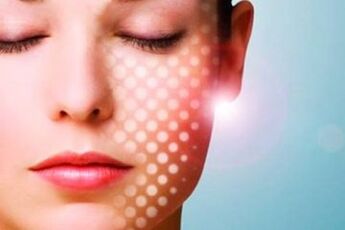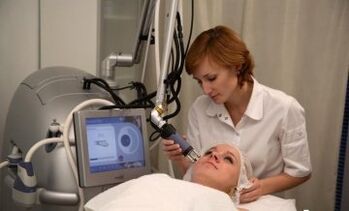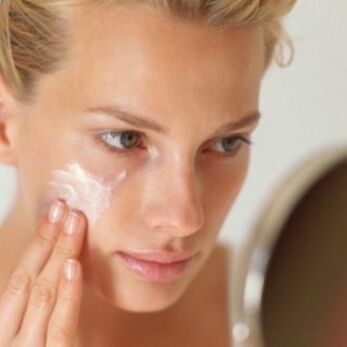
Fractional thermolysis (facelift) is a method of laser "recovery" of the face and body to help deal with age-related and stressful skin problems.
This procedure is almost as effective as surgical braces, and after thermolysis, skin cells begin to actively produce collagen and elastin as in their youth, that is, beneficial changes take place in several layers at once, not just in the outer epidermis.
The procedure is very effective, but at the same time traumatic. This can only be done in specialized clinics.
What it is - fractional photothermolysis, the essence and effectiveness of the method, indications and contraindications for facial and body procedures using fraxel technology, photos before and after, the consequences and reviews of the laser procedure, the expected costs and what devices are used - we will try to tell you more.
general information
Thermolysis refers to the process of structural destruction of tissues at high temperatures. The concept was developed and mediated by doctors and later used by cosmetologists.
And photothermolysis is also a process of thermolysis, but it is caused by the effects of light energy. It is used in cosmetology during photoepilation and laser "resuscitation" of scars and scars.
Fractional photothermolysis is a method in which photothermolysis does not affect the entire surface of the skin, but only individual areas. This means that we can talk about the destruction of focal tissues by heating them with the help of laser (light) energy.
The essence of the procedure and other names
The fractional photothermolysis procedure is classified as a negative method of skin stimulation because of some injury, in this case burns, during the session.
To achieve the expected cosmetic result, a regeneration process must be initiated that restores the skin after the injury.
This type of thermal burn appears to appear as a "column" in the dermal story under the action of targeted laser beams. This "column" is referred to in cosmetology as the "microscopic treatment zone, " or MLZ for short.
Their diameter should not exceed one tenth of a millimeter: about 0, 1 to 0, 4 mm, and the penetration depth - up to 0, 5 mm. Depending on the type of procedure chosen, there may be between ten and several thousand such microtraumas per square centimeter of surface, and the impact velocity may be 3000 MLZ / sec.
If we analyze the mechanism of action of fractional photothermolysis, it is similar to mesoscooter therapy, but using a roller, microdamages are done mechanically with needles.
In the practice of cosmetology, the concept of fractional thermolysis has some of the most commonly used synonyms:
- optical thermal thermolysis of the skin;
- DOT therapy;
- fractional laser "polishing";
- LAFT rejuvenation;
- fractional laser nanoperforation;
Ablative and non - ablative method
Laser ablation is the evaporation of a substance using a laser pulse. In ablative fractional photothermolysis, then choose the type of laser radiation whose energy is mainly absorbed by the water molecules.
During a short-term exposure to a localized site, the laser beam heats the water in the tissues almost immediately to 30 ° C. As a result, the entire "column" evaporates and is replaced by an open microscopic wound surrounded by layers of thermally coagulated cells.
Recovery after ablation photothermolysis will be much slower and longer than with nonablation method.
But the results of the procedure will be objectively better and the lifting effect will be clearer. It is best to use a course of 2-6 sessions. However, during such procedures, the patient is at some risk of infecting the tissues in the deep layers of the skin.
Non-blatant fractional thermolysis may be associated with milder microtrauma methods. A laser beam is used, which practically does not damage the epidermis, followed by burns.
The tissues to be destroyed do not evaporate and remain within the "column", naturally without open wounds.
It is recommended to use the courses from 3 to 10 sessions. There is virtually no risk for the patient to infect the deep layer of the skin as the integrity of the surface is not compromised.
Indications, effects
Indications for prescribing a procedure using Fraxel technology may include the following:
- the need to stimulate wilted and aging skin;
- treatment of pigmented / depigmented lesions;
- get rid of scars, after acne and small scars;
- the need to remove stretch marks.
Not suitable for getting rid of keloid derivatives.
Benefits
How is this method different from the classic "laser polishing"? In the traditional method, the burn affects a large area, and in the case of partial exposure, it has a localized and point nature.
There are gaps between the skin with intact skin, so photothermolysis is less traumatic and speeds up the healing time.
The method is suitable for treating any part of the body, but is most commonly used for the face. Using Fraxel technology, a cosmetologist can even work on the skin on the eyelids.
A feature of this optical dermal thermolysis is the innovative design of the DOT device itself, which avoids the lack of skin areas or the overlap of one area on top of another.
Mechanism of action
During the preliminary consultation, the cosmetologist identifies the goals that the client wants to achieve, finds out the possible contraindications to the procedure, talks about the possible results and their compliance with the client's expectations.

Your doctor will certainly prescribe the risk and development of post-procedure complications, as well as how to care for your skin after a course of photothermolysis.
It is necessary to discuss and choose the appropriate method of pain relief in advance, and the client must be sure to report allergic reactions to the medication, if any.
A few hours before the session, a superficial exfoliation is performed to smooth the thickness of the stratum corneum.
During the operation, the patient may experience moderate pain and discomfort. Their severity can in no way depend on the model of apparatus used. The level of pain depends on the depth and intensity of the laser beam, and these parameters are determined by the specialist himself, focusing on therapeutic goals.
The more neglected the problem, the deeper the layers need to be affected.
However, regular anesthetic creams are usually used as anesthetics and applied to the workplace no more than 40 minutes before the start of the session.
During the session, the beautician moves the tip through the surface, which emits a target laser beam. If such a need arises, the same area is re-processed using the same procedure.
Duration from 15 minutes to 1 hour. It all depends on how much skin is treated. At the end of the fractional photothermolysis, a soothing cream is applied to the "polished" surface.
To achieve the desired result, it is necessary to perform a course of several procedures - from 3 to 10, depending on the type of exposure selected. You can hold a session once a month.
Recommendations (training and rehabilitation)
The patient should start a prophylactic course of antibiotics and antiviral medication a few days before the scheduled procedure. Naturally, if there is objective evidence for this.
On the day of fractal photothermolysis, one should avoid alcohol and abstain completely from any sport.

After the non-ablation photothermolysis procedure, the healing process takes up to three days, after the ablation type - at least a week.
If the "polish" was based on ablation, the patient will have reddened skin, swelling, a burning sensation, and discomfort for a few more days.
After consulting a specialist, you can apply cooling compresses or apply topical analgesics to the skin, which are available as a spray.
After at least three days, the color of the "polished" dermis may change slightly. For example, it may become pseudo-tanned due to the breakdown of residual pigmented cells from previously necrosis cells.
Dryness will occur, peeling will begin and the person may feel itchy even for a short time. All of these manifestations are not dangerous and will go away on their own in about a week. It is strictly forbidden to scratch itchy skin!
For complicated post-fractal rehabilitation, a few key recommendations are needed:
- the skin should be cared for and the recommended external products should be applied. In most cases, these are medications for the treatment of thermal burns and moisturizing sprays;
- crusts formed on the surface during wound healing should not be artificially removed, only fall off naturally;
- if the patient was taking antimicrobials and antiviral drugs before the procedure, then their course should be continued according to the instructions;
- to prevent hyperpigmentation, the treated skin must be isolated from direct sunlight for at least a month. Usually use sunscreens with SPF 40+;
- The use of scrubs and other mechanical skin cleansers is prohibited throughout the recovery period.
Possible side effects and complications
Despite the fact that fractional photothermolysis is one of the most modern and safest methods, it also has a number of side effects:
- bacterial infection, development of streptoderm or staphyloderma;
- erythema lasting more than three days;
- edema on the surface of treated skin lasting more than two days;
- hyperpigmentation in the post-inflammatory period;
- appearance of burn blisters, erosive cracks;
- Exacerbation of HSV1 or acne;
- microscopic bleeding under the skin.
Contraindications (general and local)

Fractional photothermolysis is not performed in the following general contraindications:
- oncological tumors;
- breastfeeding period;
- HSV1 and HSV2 in the acute stage;
- infectious diseases;
- in the onset of chronic disease;
- diabetes of any type;
- cardiovascular defects and failure;
- disorders of the organs of the hematopoietic system, poor blood clotting;
- the presence of autoimmune diseases;
- tendency to form deep keloid-type scars;
- epileptic condition or convulsive syndrome;
- mental disorders;
- isotretinoin use for six months;
- a recent tan or a visit to the solarium.
And the following local contraindications:
- all inflammatory processes localized in the intended workplace;
- impaired skin integrity;
- any tumors of unknown origin;
- dry skin cleansing or any other procedure that can damage the skin.
Approximate prices for where and with what facilities are performed

The cost of one facelift procedure depends on the area treated, so the estimated cost of fractional laser resurfacing varies.
Photothermolysis sessions in a cosmetology hospital can only be performed by qualified specialists.
CO2 or erbium laser devices are used for the facelift rejuvenation procedure itself. Ordinary beauty salons usually do not have the necessary equipment or trained staff.
The use of lasers for cosmetic purposes is still controversial. But no matter what, laser-based procedures are one of the most popular, effective, and safest.
Feedback
We invite you to read some reviews about facial fractional laser skin rejuvenation:
- First Review: "I am 35 years old. 2 sessions of fractional photothermolysis were performed. The second visit took place 30 days after the first visit. As a result, I noticed that my pores, usually slightly enlarged, shrank, and the skin on my forehead and cheeks began to look much smoother. I was satisfied. The only thing that caused me discomfort was the peeling that occurred after the second visit. But after three days he disappeared without a trace. Now I look in the mirror and rejoice in my face.
- Second review: "I want to share my impression of this method because I felt a positive result. After three procedures, I noticed that the face became lighter, pigment spots appeared in some areas of the face, scars became less noticeable, and the skin tightened. These changes did not happen immediately, but gradually. About 4 months later, I started to look 5-6 years younger than my age. I advise anyone who cares about themselves to try this amazing thing.
- Third Review: "I was very afraid of such procedures, believing that they had more side effects than pluses. However, with the appearance of the first wrinkles, the idea of a "miraculous transformation of the skin" became more and more common in my mind. So I decided to have a photothermolysis session. color, solidified contour. In general, I liked the effect. If necessary, I will use this procedure again.
- Fourth Review: "I think this method is a must for every woman who wants to stay young and attractive. I discovered something new for myself and was left extremely happy. There are a lot of positive moments and all of them are reflected in my face: no more small wrinkles and pigmentation, less sagging skin, less inflammation, and most importantly, I like it a lot more. I want to advise everyone to love themselves, not save for their beauty, and use effective procedures to support youth.
















































































